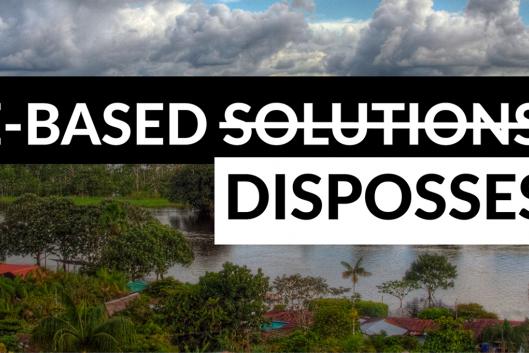It is imperative to understand the concept of ‘nature-based solutions,’ to name it for what it is: ‘nature-based solutions dispossessions’, and to expose the real threat it poses to territories, forest populations and the climate. This bulletin brings together reflections of what drives these dangerous corporate dispossessions.
We have seen the introduction of concepts that cause damage in territories and justify continued devastation of forests and violent extraction of anything from minerals to timber before. Certification schemes, carbon offsetting, net-zero deforestation supply chain promises, net-zero and carbon neutral promises are just a few of them. The latest dangerous idea goes by the name ‘Nature-based Solutions’ or ‘Natural Climate Solutions.’ It creates the illusion that ‘nature’ is a ‘solution’ to corporate destruction. And the more often we hear words that associate ideas with one another - like ‘nature’ and ‘solution’ – and the more we repeat and use these terms, the more likely that this association is considered ‘common sense.’
Corporate ‘nature-based solutions’ dispossessions include much of what communities have been fighting against for decades: industrial tree plantations, Protected Areas, REDD projects, carbon and biodiversity offsets, biofuel plantations, etc. Another thing these ‘solutions’ have also in common is that they allow the continuation of another set of corporate activities that similarly have faced resistance in the territories: mining, oil and gas extraction, large-scale infrastructure, agribusinesses, etc.
The idea that ‘nature’ is a ‘solution’ pushes these destructions and dispossessions even further. Almost every month, another major polluter announces its plans to turn its operations ‘carbon neutral’, mainly through investing in the so-called ‘Nature-based Solutions’.
This bulletin brings together reflections on what drives these dangerous corporate dispossessions.
One article in this bulletin shows that despite the enthusiasm of polluting industries to use these ‘nature-based solutions’ dispossessions for their greenwashing and profit-seeking purposes, the concept was in fact developed by big conservation NGOs as a mechanism to fund Protected Areas. Based on the colonial and racist idea that ‘nature’ is better off without people, part of the conservation industry's plan to turn ‘nature’ into a ‘solution’ for corporations, is to increase the area of land it controls.
Another article reflects on the meaning of ‘nature’ in this discourse, which is based on the destructive relation of Western culture with ‘nature’. The article shows how the romantic idea of ‘untouched nature’ goes along with a happy talk about new ‘solutions’. An idea that can be sustained as long as the factual loss, the destruction of ‘nature’ and livelihoods, that follows its instrumentalization as an exploitable resource, remains hidden.
A call for reflecting on the concept of ‘intersectionality’ is put forward in another article. The author highlights the importance of understanding how various layers of oppressions can coalesce or intersect in one subject, for example, for an indigenous, landless migrant woman. Schemes such as the ‘nature-based solutions,’ which instrumentalizes ‘nature’ in itself, the author concludes, require inclusion of ‘nature’ as another essential ‘intersection’ of various oppressions.
The concept of ‘nature-based solutions’ might be building a dangerous perverse ‘collective imaginary’ of what ‘nature’ should do for humans. When understanding the interests at play and its proponents, it becomes clear that the concept is a dangerous threat for forests and forest populations. There can be no discussion on ‘solutions’ to the climate crisis, as long as the real drivers of this crisis are not named and their destruction stopped.
Three bulletin articles in this bulletin highlight how three different polluting industries are at the forefront of promoting what is perhaps more appropriately called ‘nature-based dispossessions’: the mining industry, the oil industry and the agro industries. Each of these articles asks: Who are these ‘solutions’ for? What are they actually solving? Who is profiting? and Who is at the loosing end?
Another article in the bulletin shares some experiences of women in Brazil who have been impacted by the ‘green economy’ –as a starting point for a reflection on what today is called ‘nature-based solutions’. The article warns, among others, about the purplewashing by big conservation NGOs: a gender agenda that seems to put women at the center of these projects but which promote models of relations with nature that are ultimately patriarchal and excluding.
Another article in this bulletin emphasizes how the ecological crisis does not mean the same for everyone. What ecological crisis means to the richest men on Earth, as capitalists, is the effect it has on their investments. So the ‘solution’ to this effect (not to the crisis, of course) must be found somewhere, somehow… By exploring questions like where can the rich invest their money on an increasingly debilitated and uninsurable planet full of potentially crippling environmental lawsuits, unruly affected communities, restive green consumers, and troublesome carbon regulation, so that profits can continue accumulating in their hands?, the author takes us along the assumptions of some of the ‘space cadets’ of our green times.
It is imperative to understand and name the concept of ‘nature-based solutions’ dispossessions for what it is: another lifeline to the destructive capitalist economy. This destruction can now not only destroy livelihoods, territories, forests, water streams, basins, grasslands, and the many more life spaces on Earth, but also can enclose forest peoples’ territories in the name of ‘conservation’ and peasants’ fertile land for planting industrial plantations in the name of ‘saving the climate.’
‘Nature-based solutions’ dispossessions are a dangerous threat to territories, forest populations and the climate.
